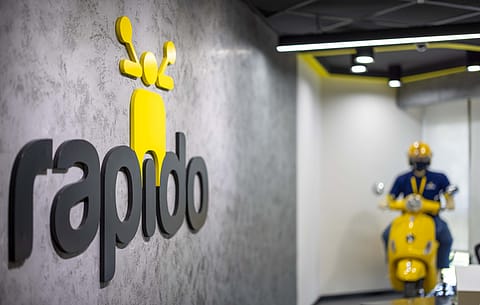Can Rapido’s bike army outflank Zomato and Swiggy in India’s food delivery wars?
Rapido’s entry comes with a flat commission model of 8-15% for restaurant partners—which is significantly lower than Zomato and Swiggy’s blended 21-22%.

Bike-taxi platform Rapido is making a bold foray into India’s online food delivery market—betting on its sprawling 4-million-strong rider base to undercut Zomato and Swiggy’s dominance. Its pitch: lower commissions, better rider utilisation, and minimal additional investment. But while the proposition sounds attractive on paper, the absence of a dedicated delivery fleet could create friction in consumer experience—especially as the industry pivots towards faster, more time-sensitive deliveries.
Rapido’s entry comes with a flat commission model of 8-15% for restaurant partners—which is significantly lower than Zomato and Swiggy’s blended 21-22%. For consumers, the company may fix a delivery fee of ₹25 for orders below ₹400 and ₹50 for orders above ₹500, reportedly. The service will first pilot in Bengaluru.
Karan Taurani, executive vice president of Elara Capital, sees this move as an aggressive bid to optimise idle capacity without substantial capital deployment. “Rapido will cross-utilise its 4 million-strong fleet, which already completes over 3 million rides daily, to fulfill food deliveries during idle slots,” he says. “This allows them to expand into food delivery with virtually zero incremental capex and improve rider earnings.”
Unlike ONDC or Ola’s earlier attempts, where last-mile logistics and delivery reliability posed challenges, Rapido’s core advantage lies in its operational base and fleet utilisation. With a much larger rider pool compared to Swiggy (0.44 million) and Zomato (0.53 million), Rapido plans to consolidate rides, parcels, and food orders into a single “captain app.” Intelligent algorithms will assign deliveries to maximise earnings and reduce travel distances, improving overall efficiency, according to Elara Capital’s report.
But Taurani warns that quality of service will be a critical test. “The challenge is not just logistical scale—it’s optimising for very different service expectations. Ride-hailing and food delivery demand very different rider behaviours, especially with the rise of <30-minutes delivery norms. Without a dedicated fleet, the risk of subpar consumer experience increases.”
He points to how previous entrants—Uber Eats, ONDC, Ola, and Thrive—struggled to maintain user experience and failed to scale. “Even with a logistics edge, Rapido will need sustained execution to avoid past pitfalls,” he says.
Upon being probed about Rapido’s subscription-based model, Eternal CFO Akshant Goyal, in a post-earnings call with analysts last month, said he was not clear “how that model can make sense in the long run for all our stakeholders and us”.
There’s also a broader market implication. Food delivery in India, after a phase of breakneck growth (~40% CAGR during 2018-23), has now stabilised to ~15-16% YoY. As the sector matures, take rates for platforms have also stabilised, and the leading players are now targeting 5% adjusted EBITDA margins, as per the report.
If Rapido’s model gains traction and it begins aggressively subsidising orders or commissions to scale up, it could put pressure on margins for incumbents. “A sharp scale-up from Rapido could disrupt the operational stability of Zomato and Swiggy,” says Taurani while adding, “Expect them to respond cautiously, as their focus is now on profitability.”
From an investment standpoint, Rapido’s move could introduce uncertainty into the food delivery segment’s valuations. A sensitivity analysis by Elara Capital shows that even a modest decline in growth or valuation multiples for food delivery could drag down target prices. “If GOV growth dips by 200 basis points or valuation multiple drops by 10%, our consolidated target price (TP) for Eternal—which derives 45% of its value from food delivery—would fall 6%, from ₹300 to ₹282,” Taurani notes. In a more severe scenario, with GOV growth at 15% and multiples falling to 44x, the TP could drop 12% to ₹263.
Rapido raised $29 million in December 2024 at a valuation of $1.1 billion, taking its total fundraising tally to $559 million so far. But breaking into a category where Zomato alone has invested ~$400 million in advertising and promotions over FY20–22 will still require clever execution—even if the upfront marketing spend is relatively muted for a late entrant.
(INR CR)
For now, all eyes are on Rapido’s Bengaluru pilot.